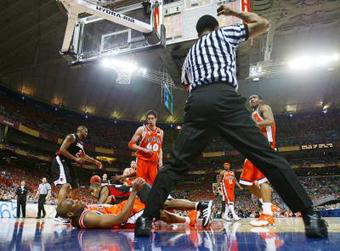- Offensive Techniques & Strategies
Avoiding Foul Trouble

Fouling plays a critical part in the out come of the game, especially when it comes playoff time. Fouls were added to the basketball rule book to penalize; however, intelligent players and teams use fouls to their advantage. When it comes to fouling to gain a competitive edge there is no margin for error. The difference between fouls being your ally or your enemy rests on a single foul. If you analyze fouling, you will quickly see that every time you step onto the court you can count on receiving three basic fouls:
Foul #1 - You will receive at least one bad call during the game.
Foul #2 - At least one charge/block judgment call will go against you.
Foul #3 - You will use at least one foul for strategy reasons.
Therefore, if you commit just one careless or lazy foul you are in foul trouble (Foul #4). You may commit a careless foul early in the game and think it is only your first foul. However, since the other three basic fouls are definitely coming it immediately puts you in foul trouble. Once you are in foul trouble you be come a defensive liability especially in the low post area. In the low post area, you will be forced to play behind your opponent with your hands up like a "prisoner" and only hope that your opponent does not score. If your opponent is smart they will take "no prisoners" and attack you at every opportunity.

What Constitutes a Careless or Lazy Foul?
Reaching instead of moving your feet to establish good defensive position.
Reaching because you are tired and out of condition.
Fouling out of frustration after a bad call or play. Committing a technical foul. Since most leagues now count technical fouls toward disqualification, loss of control not only puts you in foul trouble but also creates an unforced turnover! (See "Playing Through Adversity" Article).
Fouling because you are too slow getting back on defense and are out of position.
Trying to block shots instead of taking a charge.
Going over the back of an opponent for a rebound instead of establishing good rebounding position.
Fouling a player in the act of shooting.
Playing defense by standing behind a player in the low post area.
Establishing defensive stance after your opponent has already received the ball.
Fouling a dribbler from the side.
Committing an offensive foul by driving into a crowd.
Creating a foul on your teammate by coming off a screen before the screen has been set.
© 2026 HoopTactics All Rights Reserved.
